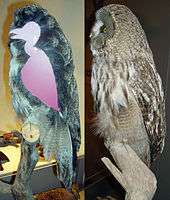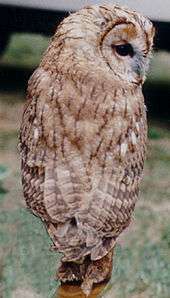True owl
| True owl Temporal range: Early Eocene to present | |
|---|---|
 | |
| Eastern screech owl | |
| Scientific classification | |
| Kingdom: | Animalia |
| Phylum: | Chordata |
| Class: | Aves |
| Order: | Strigiformes |
| Family: | Strigidae Vigors, 1825 |
| Genera | |
|
some 25, see text | |
| Synonyms | |
|
Striginae sensu Sibley & Ahlquist | |
The true owls or typical owls (family Strigidae) are one of the two generally accepted families of owls, the other being the barn owls (Tytonidae). The Sibley-Ahlquist taxonomy unites the Caprimulgiformes with the owl order; here, the typical owls are a subfamily Striginae. This is unsupported by more recent research (see Cypselomorphae for details), but the relationships of the owls in general are still unresolved. This large family comprises around 189 living species in 25 genera. The typical owls have a cosmopolitan distribution and are found on every continent except Antarctica.
Morphology

While typical owls (hereafter referred to simply as owls) vary greatly in size, with the smallest species, the elf owl, being a hundredth the size of the largest, the Eurasian eagle-owl and Blakiston's fish owl, owls generally share an extremely similar body plan.[1] They tend to have large heads, short tails, cryptic plumage, and round facial discs around the eyes. The family is generally arboreal (with a few exceptions like the burrowing owl) and obtain their food on the wing. The wings are large, broad, rounded, and long. Like for other birds of prey, in many owl species females are larger than males.[2]
Because of their nocturnal habits, they tend not to exhibit sexual dimorphism in their plumage. The feathers are soft and the base of each is downy, allowing for silent flight. The toes and tarsi are feathered in some species, and more so in species at higher latitudes.[3] Numerous species of owls in the genus Glaucidium and the northern hawk-owl have eye patches on the backs of their heads, apparently to convince other birds they are being watched at all times. Numerous nocturnal species have ear-tufts, feathers on the sides of the head that are thought to have a camouflage function, breaking up the outline of a roosting bird. The feathers of the facial disc are arranged in order to increase sound delivered to the ears. Hearing in owls is highly sensitive and the ears are asymmetrical allowing the owl to localise a sound. In addition to hearing, owls have massive eyes relative to their body size. Contrary to popular belief, however, owls cannot see well in extreme dark and are able to see fine in the day.[1]
Behavior
Owls are generally nocturnal and spend much of the day roosting. They are often perceived as tame since they allow people to approach quite closely before taking flight, but they are instead attempting to avoid detection. The cryptic plumage and inconspicuous locations adopted are an effort to avoid predators and mobbing by small birds.
Systematics

The nearly 200 extant species are assigned to a number of genera, which are in taxonomic order:
- Genus Megascops – screech-owls, some 20 species
- Genus Otus – scops owls; probably paraphyletic, about 45 species
- Genus Pyrroglaux – Palau owl
- Genus Margarobyas – bare-legged owl or Cuban screech-owl
- Genus Ptilopsis – white-faced owls, two species
- Genus Bubo – horned owls, eagle-owls and fish-owls; paraphyletic with Nyctea, Ketupa and Scotopelia, some 25 species
- Genus Strix – earless owls, some 19 species, including four that were previously classified as Ciccaba
- Genus Ciccaba – the four species have been transferred to Strix
- Genus Lophostrix – crested owl
- Genus Jubula – maned owl
- Genus Pulsatrix – spectacled owls, three species
- Genus Surnia – northern hawk-owl
- Genus Glaucidium – pygmy owls, about 30–35 species
- Genus Xenoglaux – long-whiskered owlet
- Genus Micrathene – elf owl
- Genus Athene – two to four species (depending on whether Speotyto and Heteroglaux are included or not)

.
- Genus Aegolius – saw-whet owls, four species
- Genus Ninox – Australasian hawk-owls, some 20 species
- Genus Uroglaux – Papuan hawk-owl
- Genus Pseudoscops – Jamaican owl and possibly striped owl
- Genus Asio – eared owls, six or seven species
- Genus Nesasio – fearful owl
Recently extinct
- Genus Mascarenotus – Mascarene owls, three species (extinct c. 1850)
- Genus Sceloglaux – laughing owl (extinct 1914?)
Late Quaternary prehistoric extinctions
- Genus Grallistrix – stilt-owls, four species
- Kaua‘i stilt-owl, Grallistrix auceps
- Maui stilt-owl, Grallistrix erdmani
- Moloka‘i stilt-owl, Grallistrix geleches
- O‘ahu stilt-owl, Grallistrix orion
- Genus Ornimegalonyx – Caribbean giant owls, one or two species
- Cuban giant owl, Ornimegalonyx oteroi
- Ornimegalonyx sp. – probably subspecies of O. oteroi
- Genus Asphaltoglaux
Fossil record
- Mioglaux (Late Oligocene? – Early Miocene of WC Europe) – includes "Bubo" poirreiri
- Intulula (Early/Middle Miocene of WC Europe) – includes "Strix/Ninox" brevis
- Alasio (Middle Miocene of Vieux-Collonges, France) – includes "Strix" collongensis
Placement unresolved:
- "Otus/Strix" wintershofensis – fossil (Early/Middle Miocene of Wintershof West, Germany) – may be close to extant genus Ninox[4]
- "Strix" edwardsi – fossil (Middle Miocene of Grive-Saint-Alban, France)
- "Asio" pygmaeus – fossil (Early Pliocene of Odessa, Ukraine)
- Strigidae gen. et sp. indet. UMMP V31030 (Rexroad Late Pliocene of Kansas, USA) – Strix/Bubo?[5]
- Ibiza owl, Strigidae gen. et sp. indet. – prehistoric (Late Pleistocene/Holocene of Es Pouàs, Ibiza)[6]
The supposed fossil heron "Ardea" lignitum (Late Pliocene of Germany) was apparently a strigid owl, possibly close to Bubo.[7] The Early–Middle Eocene genus Palaeoglaux from west-central Europe is sometimes placed here, but given its age, it is probably better considered its own family for the time being.
References
- 1 2 Marks, J. S.; Cannings, R.J. and Mikkola, H. (1999). "Family Strigidae (Typical Owls)". In del Hoyo, J.; Elliot, A. & Sargatal, J. (eds.) (1999). Handbook of the Birds of the World. Volume 5: Barn-Owls to Hummingbirds. Lynx Edicions. ISBN 84-87334-25-3
- ↑ Earhart, Caroline M. & Johnson, Ned K. (1970). "Size Dimorphism and Food Habits of North American Owls". Condor. 72 (3): 251–264. doi:10.2307/1366002.
- ↑ Kelso L & Kelso E (1936). "The Relation of Feathering of Feet of American Owls to Humidity of Environment and to Life Zones". Auk. 53 (1): 51–56. doi:10.2307/4077355.
- ↑ Olson, p. 131
- ↑ Feduccia, J. Alan; Ford, Norman L. (1970). "Some birds of prey from the Upper Pliocene of Kansas" (PDF). Auk. 87 (4): 795–797. doi:10.2307/4083714.
- ↑ Sánchez Marco, Antonio (2004). "Avian zoogeographical patterns during the Quaternary in the Mediterranean region and paleoclimatic interpretation" (PDF). Ardeola. 51 (1): 91–132.
- ↑ Olson, p. 167
Bibliography
- Olson, Storrs L. (1985). The fossil record of birds. In: Farner, D.S.; King, J.R. & Parkes, Kenneth C. (eds.): Avian Biology 8: 79–238. Academic Press, New York.
External links
| Wikimedia Commons has media related to Strigidae. |
- ITIS – Strigidae Taxonomy
- Typical owl videos on the Internet Bird Collection
- Strigidae sounds from the Neotropics on xeno-canto.org
- The Owl Pages about owls – photos, calls, books, art, mythology and more.
